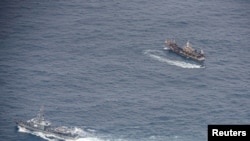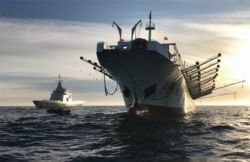Ecuador's navy confirmed a large Chinese fishing fleet of roughly 300 vessels is moving away from the Galapagos Islands and is now operating in international waters off Peru.
The Ecuadorian commander of naval operations, Rear Admiral Daniel Ginez, said this week that the Chinese vessels are now "in offshore waters off the exclusive economic zone of Peru."
He added that this year's fleet was larger compared with those of previous years.
"With such a large number of fishing boats, we have the risk that certain species are diminished," Ginez cautioned.
Experts told VOA that China's aggressive fishing not only threatens the sovereignty of coastal countries but also endangers global food security and marine ecology.
Complaints from South American countries
China's large fishing fleets operating along the Pacific coast have triggered concerns from several South American countries for the past few months. In June, about 340 large Chinese trawlers ventured into waters near Ecuador, triggering protests over possible threats to the Galapagos Islands, a UNESCO World Heritage site and home to many unique species.
These Chinese vessels were accused of frequently turning off their satellite-based automatic identification systems and entering the Ecuadorian exclusive economic zone, according to media reports. Yet Ecuador's Admiral Ginez said no vessels of the fishing fleet entered Ecuadorian waters while operating near the Galapagos.
Peru's and Ecuador's economies are highly dependent on seafood. In 2018, the two countries captured 4.5 million metric tons of fish, nearly as much as the United States, but only 25% of what China harvested in the same year, according to statistics from the World Bank.
Both countries say China's mega fishing fleets are threatening the security of their food source.
China ranks at the top of the world in demand for seafood. The country's fish consumption accounts for one-third of the world's total amount, with an annual growth rate of 6%.
Illegal fishing
Analysts say many Chinese vessels conduct "illegal, unreported and unregulated (IUU)" fishing activities that threaten the sovereignty of other nations and endanger the global food security chain.
President Donald Trump on Tuesday singled out Chinese fishing practices in his speech to the United Nations, saying Beijing "dumps millions and millions of tons of plastic and trash into the oceans and overfishes other countries' waters."
Rashid Sumaila, director of the Fisheries Economics Research Unit at the University of British Columbia's Institute for the Oceans and Fisheries, told VOA that with the waters near China mostly depleted of fish, the nation has to forage elsewhere.
"There is big appetite for fish in China, which makes it worthwhile economically to engage in IUU fishing," he said. "There's also a lack of strong and effective anti-IUU fishing policy by China, and there's provision of significant harmful subsidies such as those for fuel."
The London-based Overseas Development Institute (ODI) has documented nearly 17,000 Chinese fishing vessels, making it nearly impossible to sufficiently monitor all of them worldwide.
Tabitha Mallory, an affiliate professor specializing in Chinese foreign and environmental policy at the University of Washington, told VOA it's hard for developing countries to properly monitor coastal waters.
"China fishes in countries that don't have the ability to monitor their coastal waters well," she said. "Coast guard vessels and fuel for those patrol vessels are often cost prohibitive for developing countries."
U.S. Senator Jim Risch, an Idaho Republican and the chairman of the Senate Foreign Relations Committee, said last week that the international community needs to pressure China to improve its industrial fishing practices.
"Aggressive and illegal Chinese fishing practices violate the territorial integrity of coastal Latin American countries, raising significant long-term security concerns," Risch said.
China has promised a "zero tolerance" policy toward illegal fishing and has proposed a moratorium in the area near the Galapagos.
According to China's Ministry of Agriculture and Rural Affairs, the moratorium bans all Chinese fishing fleets on parts of the high seas in the southwest Atlantic and east Pacific for three months, effective July 1.












